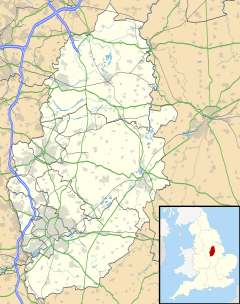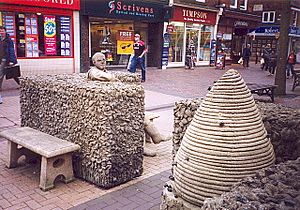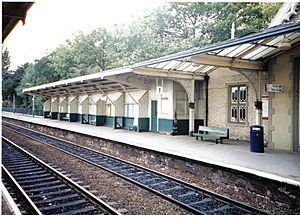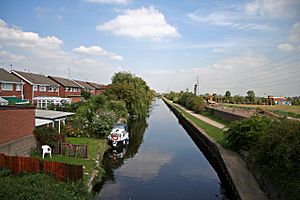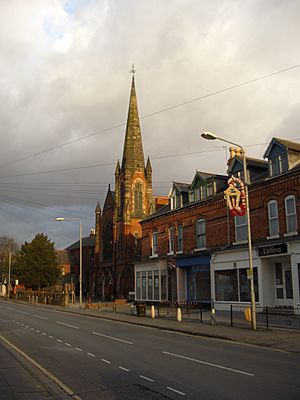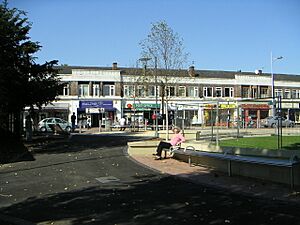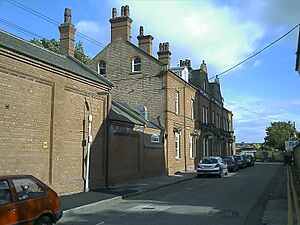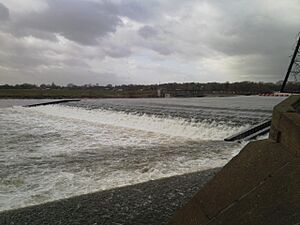Beeston, Nottinghamshire facts for kids
Quick facts for kids Beeston |
|
|---|---|
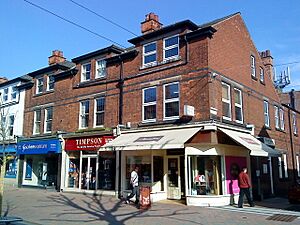 High Road, Beeston |
|
| Population | 37,000 (2011 census) |
| OS grid reference | SK 52764 36944 |
| Civil parish |
|
| District |
|
| Shire county | |
| Region | |
| Country | England |
| Sovereign state | United Kingdom |
| Post town | NOTTINGHAM |
| Postcode district | NG9 |
| Dialling code | 0115 |
| Police | Nottinghamshire |
| Fire | Nottinghamshire |
| Ambulance | East Midlands |
| EU Parliament | East Midlands |
| UK Parliament |
|
Beeston (/ˈbiːstən/) is a lively town in Nottinghamshire, England. It is about 3 miles (5 km) south-west of the city of Nottingham. The main campus of the University of Nottingham is just north-east of Beeston. Also, the main office of the big pharmacy company Boots is located nearby. To the south, you'll find the River Trent and the village of Attenborough, known for its wide wetlands.
Contents
- What's in a Name? The Story of Beeston
- A Look Back: Beeston's History
- Where is Beeston? The Town's Geography
- What Does Beeston Make? The Economy
- Who Lives in Beeston? The People
- Getting Around: Transport in Beeston
- Buildings and Places of Interest
- Shopping and Fun: Commerce in Beeston
- Sports in Beeston
- Beeston Hydroelectric Plant
- Famous People from Beeston
What's in a Name? The Story of Beeston
The earliest name for Beeston was Bestune, recorded in a very old book called the Domesday Book in 1086. This name comes from old English words meaning "bent-grass farmstead." Bent-grass is a type of grass often found in fields.
Some people in Beeston like to think the name comes from the word "bee." This idea made people think of Beeston as a "hive of industry," meaning a busy place. The bee became a symbol for the town. You can even see beehives carved on the outside of the town hall! In 1959, three bees were put on the town's official coat of arms.
Today, the bee tradition continues. Many litter bins and street decorations in the High Road have a bee symbol. There's also a famous sculpture in the High Road of a man sitting next to a beehive. People call it the "Bee-man" or "the man of Beeston." The artist, Sioban Coppinger, made it in 1987.
A Look Back: Beeston's History
Beeston in the Domesday Book
In 1086, after the Norman Conquest, Beeston was a small settlement. The land was given to William Peverel, who was the lord of Nottingham Castle. At that time, there were 17 bond tenants, who were like farmers tied to the land. They worked the land, and there were also meadows for animals.
Growing as a Town: The 19th Century
Beeston started to grow from a small village in the early 1800s. It became known for making silk. The first silk mill here was sadly burned down during riots in 1831. When the silk industry slowed down, many old mills were used for other light industries. You can still find equipment made by the Beeston Boiler Company in many places that used to be part of the British Empire.
Between 1880 and 1900, a company called Humber made bicycles, motorcycles, and even cars in Beeston. They had a factory that employed 2,000 people! However, the company moved away in 1907.
Beeston in the 20th Century
In 1901, a factory for telephone parts was built in Beeston. This factory became a major employer for many years, known as Ericsson and later Plessey. Today, a company called SMS Electronics, which makes electronics, operates from part of this site. They even won an award for their exports in 2012.
The Boots company campus in Beeston has some very special buildings. Three of them are famous for their modern design by engineer Owen Williams. These buildings are protected because of their unique architecture.
Motorcycle making came back to Beeston for a short time in 1987. A company called Middlebridge made 77 Scimitar cars here before closing in 1990.
The Beeston Maltings, a place where grain was prepared for brewing, operated until the late 1900s. The buildings were taken down in 2012–2013.
Beeston in the 21st Century
In 2009, plans were approved to build a tram line through Beeston. This was part of the Nottingham Express Transit system. Some people worried about businesses during construction, but many supported the idea. The tram line officially opened on August 25, 2015.
Where is Beeston? The Town's Geography
Beeston has grown over time, joining up with nearby villages like Chilwell and parts of Wollaton. The town is separated from Bramcote by the Beeston Fields Golf Course. The main shopping area is north of the railway line. To the south of the railway is Beeston Rylands, which has homes and industrial areas.
Beeston Rylands: South of the Tracks
Beeston Rylands started as a small group of houses near Beeston Lock on the canal. Now, the name refers to the whole area south of the railway line. In the early 1900s, many houses were built here for workers at the Ericsson and Boots factories.
Historically, Beeston Rylands was at risk of flooding from the River Trent. The last big flood was in 1947. However, new flood defenses have been built, costing £51 million, to protect the area better.
University of Nottingham's Neighbor
The eastern edge of Beeston is right next to the main campus of the University of Nottingham.
How Beeston is Divided: Wards
Beeston is divided into four areas called wards for local elections: Beeston North, Beeston Central, Beeston Rylands, and Beeston West. Each ward chooses two local councillors.
The town centre is mostly in the West and Central wards. Beeston Rylands ward is larger because it includes floodplains and industrial areas, like part of the Boots campus.
What Does Beeston Make? The Economy
Beeston is home to many companies, both national and international. Some of the biggest companies based here include Boots, Changan, Imperial Tobacco, ZF, and Atos. Other local businesses include Myford, which makes metalworking lathes.
Who Lives in Beeston? The People
Beeston has a population of 37,000 people. About 71% of residents are from a White British background. The other 29% come from many different backgrounds, including Chinese, European, Indian, and Pakistani.
Getting Around: Transport in Beeston
Trains
Beeston has its own railway station, which opened in 1839. Today, you can catch trains from Beeston to many places. East Midlands Railway offers services to Nottingham, London St Pancras, and other towns like Derby and Matlock. CrossCountry trains connect Beeston to Nottingham, Birmingham, and Cardiff.
Buses
Many bus services run in Beeston, provided by different companies. These buses connect the town to Nottingham city centre, the University, Queens Medical Centre, and nearby towns like Chilwell and Stapleford. Some longer routes go to Derby and East Midlands Airport.
Trams
The city's tram system, Nottingham Express Transit, came to Beeston in August 2015. The Beeston transport interchange was built at the same time, making it easy to switch between buses and trams. Trams run regularly between Toton and Hucknall, passing through Nottingham station.
Roads
The main road connecting Nottingham and Derby, the A52 road, touches the north of Beeston. It also connects the town to the M1 motorway, which is about 4 miles (6 km) away.
Canals
The Nottingham Canal was completed in 1802. It helped transport goods and allowed boats to avoid parts of the River Trent. The Beeston Canal was built to connect to the Nottingham Canal, helping boats travel more easily.
Cycling
Beeston is part of National Cycle Route 6, which goes all the way from London to Keswick. There's also a circular "Big Track" for cyclists and walkers along the River Trent and Beeston Canal. Many other cycle routes are signposted around the town.
Buildings and Places of Interest

Beeston has several old and interesting buildings. The parish church of St John the Baptist dates back to the 11th century, though it was mostly rebuilt in 1843. These buildings are part of a special "conservation area" that protects their history and character.
In the past, Beeston got its gas supply from Nottingham in 1861. Street lamps were installed in 1872. Beeston was connected to the main water supply in 1876. Electricity came to Beeston later, in 1914.
The Anglo Scotian Mills building on Wollaton Road is a historic silk and lace factory warehouse from 1892. It's a protected building.
Another rare place is the G H Hurt & Son Shawl Factory. Here, shawls are still made using knitting machines and hand-finished, much like they have been for centuries. You can even see knitting frames from the 1600s!
Planned Estates: The Land Societies
In the late 1800s, groups called "Land Societies" helped plan and build new housing areas in Beeston. They divided land into plots and set rules for building, like making sure houses were set back from the road.
- The St John's Grove Estate was developed in 1878. It has wide, straight streets and many houses from the Victorian and Edwardian eras. It is now a conservation area.
- The Imperial Park Estate and Bellevue Park Estate were also developed around this time, helping to create more homes.
- Cottage Grove, which was originally part of Chilwell, was planned in the 1840s to provide small homes with gardens for working families. It still has a leafy feel today.
Other Notable Buildings
A large Methodist Church was built in Chilwell Road in 1902. Its tall spire is a well-known landmark.
The Baptist Church in Dovecote Lane was built in 1898 but was taken down in 2015.
Almshouses
The United Charities of Abel Collin moved their almshouses (special homes for older people) to Derby Road in Beeston in the 1950s.
Shopping and Fun: Commerce in Beeston
Beeston's main shopping area is along the High Road, which is mostly for pedestrians. You'll find both big chain stores and unique independent shops, including those selling Asian and Mediterranean foods.
There are many takeaways and restaurants offering different types of food, like Chinese, Thai, and Indian. Cafés are also popular in the town centre. "The Square" is a shopping area from the 1960s, mostly for walking.
A large Tesco supermarket opened in 2010, joining the Sainsbury's and Lidl stores in town. Beeston town centre has been redeveloped with the tram line, adding a large gym and a Costa Coffee shop. There are also plans for a new cinema with eight screens, which will be the first cinema in Beeston since 1968.
Pubs
Beeston is famous for its many pubs! It has one of the highest numbers of pubs in the UK for its size, with 23 pubs in 2011. Many people enjoy the "Beeston Crawl," visiting several pubs.
The Victoria Hotel is a Victorian pub right next to the train station. It has won several awards. The Crown pub in Church Street also won "Pub of the Year" awards. There's even a Wetherspoon's pub called The Last Post in the old Royal Mail sorting office building.
A small brewery called Reality started making its own beer in Beeston in 2010.
Post Offices
Beeston currently has two post offices. The main one is now inside the WHSmith store. There's another post office in the High Road. The main Royal Mail sorting office for the Nottingham area is on the eastern edge of Beeston.
Sports in Beeston
Beeston is home to the Beeston Hockey Club, a top team in England's Hockey Premier League. They play at Highfields Sports Club.
Until 2006, Nottingham Rugby Club played in Beeston. They later moved to the Meadow Lane ground. The Nottingham Casuals Rugby Club still plays on pitches near the canal.
There are two golf courses close to town: Beeston Fields and Chilwell Manor. Beeston also has several football clubs, including Beeston Amateur Football Club. Beeston Athletics, a running club, meets at Chilwell Olympia.
Beeston Hydroelectric Plant
Beeston is home to a hydroelectric plant, which uses the power of water from the River Trent to create electricity. This plant is located near Beeston Weir.
Famous People from Beeston
Many interesting people have connections to Beeston:
- Richard Beckinsale (1947–1979): A famous actor known for TV shows like Porridge. He grew up in Beeston.
- Anne Briggs (born 1944): A well-known folk singer.
- Neil Cossons (born 1939): Former chairman of English Heritage, he grew up in Beeston.
- Barry Foster (1931–2002): An actor famous for playing the Dutch detective Van der Valk.
- Alice Levine (born 1986): A broadcaster and model.
- Edward Joseph Lowe (1825–1900): A botanist and meteorologist who lived in Beeston for most of his life.
- Sir Paul Smith (born 1946): A world-famous fashion designer who went to primary school in Beeston.
- Edwin Starr (1942–2003): A soul singer who lived and passed away in Beeston.
- Baroness Stowell of Beeston (born 1967): A former leader in the House of Lords, she attended school in Chilwell.
- W. F. Wallett (1806–1892): A 19th-century clown known as The Queen's Jester.
- Colin Hoult (born 1979): An actor and comedian known for shows like Being Human and Ghosts.


